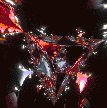
 |
The boundary between colors is "fractal", which means that if we were to look more closely -- to magnify a portion of the boundary -- what we would see would be similar to the original, unmagnified image. This is a model for three degree-of-freedom chaotic scattering. Chaotic scattering is studied in connection with chemical reactions, celestial mechanics, fluid flow, quantum cosmology, and other systems. This represents one of the first studies of the topology of a basin boundary in this type of system as well as the first directly viewable image of a fractal basin boundary in a laboratory model. |
I've made some pictures of these spheres and used color to help make the pattern clearer.
You can try this at home with four shiny, spherical Christmas tree ornaments and a flashlight. Just place three of the ornaments together on a table in a triangle (so they are touching) and place the last ornament on top. Look inside the ornament arrangement and you'll see the fractal. Shining a light inside will help bring out the image.
To get an idea of what you are looking at, see the far away shot.
Interesting pictures are this and this.
 An article describing this model and the Wada property appears in the
May 27, 1999 of Nature.
The cover image is shown here. [D. Sweet, E. Ott,
J. A. Yorke, Nature 399, 315 (1999).] The article is now available in
PDF and PostScript formats.
An article describing this model and the Wada property appears in the
May 27, 1999 of Nature.
The cover image is shown here. [D. Sweet, E. Ott,
J. A. Yorke, Nature 399, 315 (1999).] The article is now available in
PDF and PostScript formats.
 This image
appears on the cover of the newest
Institute for Physical Science and Technology print brochure.
This image
appears on the cover of the newest
Institute for Physical Science and Technology print brochure.
Here are a couple of shots which show only white regions and regions with no white at all.
A "making of" shot shows the spheres in the lab and some of the colored interior.
If you imagine four spheres stacked as shown you can tell that there are four openings, or "faces", through which light can pass. One is facing the table (on the bottom), one faces front, and the other two face somewhere between the back and the (left and right) sides.
A white sheet was placed under the bottom face, a red poster board behind the left-back face, and blue poster board behind the right-back face. The front face was left uncovered. Light was reflected off of the red and blue poster boards and shone through the white sheet. This made the reflection of each face in the spheres colored (red, blue, white, or "black" for the uncovered face).
The colors get reflected by each of the other spheres. Those reflections get reflected and so on.
The boundary between the colors forms a fractal. That is to say, if we zoomed in on any part of the boundary, we'd see smaller reflections of the colors which would, of course, have boundaries between them, and the pattern of faces and boundary would be similar no matter how far we zoomed (ideally, of course -- we could not subject real spheres to infinite magnification).
You can find some material that might be useful for teaching students about Chaos using these spheres. The material may be suitable for or adaptable to students from grade 7 to freshman year of college.
If you are using the spheres in a class I would enjoy hearing about what you are doing and would like to incorporate your ideas into the teaching materials page.
The spheres are actually meant to be used as lawn ornaments. One is supposed to place a sphere on a pedestal in one's garden and gaze at the reflections of the flowers and plants. Indeed, the balls are called "gazing spheres".
No, really.
 Now we lay the four
spheres on a table so that the sphere centers lay on the vertices of a
square. In this situation each sphere is touching only two others.
Next, we lift two opposing spheres off the table, maintaining contact
with the other spheres, and light the whole thing from the bottom (our
table is made of glass, so we can shine light through it). We see this image.
Now we lay the four
spheres on a table so that the sphere centers lay on the vertices of a
square. In this situation each sphere is touching only two others.
Next, we lift two opposing spheres off the table, maintaining contact
with the other spheres, and light the whole thing from the bottom (our
table is made of glass, so we can shine light through it). We see this image.
D. Sweet, E. Ott,
J. A. Yorke
We would like to thank
D. Lathrop,
B. Zeff, N. Peffley,
and E. Boettcher
for their assistance.